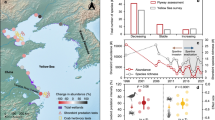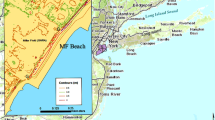Abstract
We investigated the role of beach grooming in the loss of coastal strand ecosystems. On groomed beaches, unvegetated dry sand zones were four times wider, macrophyte wrack cover was >9 times lower, and native plant abundance and richness were 15 and >3 times lower, respectively, compared to ungroomed beaches. Experimental comparisons of native plant performance were consistent with our survey results: although initial germination was similar, seed bank, survival, and reproduction were significantly lower in groomed compared to ungroomed plots. Rates of aeolian sand transport were significantly higher in groomed plots, while native plants or wrack placed in that zone reduced sand transport. Our results suggest beach grooming has contributed to widespread conversion of coastal strand ecosystems to unvegetated sand. Increased conservation of these threatened coastal ecosystems could help retain sediment, promote the formation of dunes, and maintain biodiversity, wildlife, and human use in the face of rising sea levels.







Similar content being viewed by others
References
Anderson, W.B., and G.A. Polis. 1999. Nutrient fluxes from water to land: Seabirds affect plant nutrient status on Gulf of California islands. Oecologia 118(3): 324–332.
Barbour, M.G. 1992. Life at the leading edge: The beach plant syndrome. In Coastal plant communities of Latin America, ed. U. Seeliger, 291–307. San Diego: Academic.
Barbour, M.G., and T.M. De Jong. 1977. Response of west coast beach taxa to salt spray, seawater inundation and soil salinity. Bulletin of the Torrey Botanical Club 104(1): 29–34.
Barbour, M.G., and A.F. Johnson. 1988. Beach and dune. In Terrestrial vegetation of California, ed. M.G. Barbour, and J. Major, 223–262. New York: Wiley Interscience. Reprinted with supplement by California Native Plant Society, Sacramento, CA.
Bauer, B.O., and D.J. Sherman. 1999. Coastal dune dynamics: Problems and prospects. In Aeolian environments, sediments and landforms, ed. A.S. Goudie, I. Livingston, and S. Stokes, 71–104. Chichester: Wiley.
Bird, E.C.F. 2000. Coastal geomorphology: An introduction. Chichester: Wiley.
Brown, A., and A. McLachlan. 2002. Sandy shore ecosystems and the threats facing them: Some predictions for the year 2025. Environmental Conservation 29: 62–77.
Clark, J.R. 1996. Coastal zone management handbook. Florida: CRC.
Defeo, O., A. McLachlan, D. Schoeman, T. Schlacher, J. Dugan, A. Jones, M. Lastra, and F. Scapini. 2009. Threats to sandy beach ecosystems: A review. Estuarine, Coastal and Shelf Science 81: 1–12.
De Jong, T.M. 1979. Water and salinity relations of Californian beach species. Journal of Ecology 67: 647–663.
De Jong, T.M., and M.G. Barbour. 1979. Contributions to the biology of Atriplex leucophylla, a C4 Californian beach plant. Bulletin of the Torrey Botanical Club 106: 9–19.
Dugan, J.E., D.M. Hubbard, J.M. Engle, D.L. Martin, D.M. Richards, G.E. Davis, K.D. Lafferty, and R.F. Ambrose. 2000. Macrofauna communities of exposed sandy beaches on the Southern California mainland and Channel Islands. In Fifth California Islands Symposium, 339–346. Outer Continental Shelf Study, US Department of the Interior, Minerals Management Service 99-0038, http://science.nature.nps.gov/im/units/medn/symposia/5th%20California%20Islands%20Symposium%20%281999%29/Proceedings/.
Dugan, J.E., D.M. Hubbard, M. McCrary, and M. Pierson. 2003. The response of macrofauna communities and shorebirds to macrophyte wrack subsidies on exposed sandy beaches of southern California. Estuarine, Coastal and Shelf Science. 58S: 133–148.
Feagin, R.A., D.J. Sherman, and W.E. Grant. 2005. Coastal erosion, global sea-level rise, and the loss of sand dune plant habitats. Frontiers in Ecology and the Environment 7(3): 359–364.
Fink, B.H., and J.B. Zedler. 1990. Maritime stress tolerance studies of California dune perennials. Madrono 37(3): 220–213.
Goossens, D., Z. Offer, and G. London. 2000. Wind tunnel and field calibration of five aeolian sand traps. Geomorphology 35: 233–252.
Greaver, T.L., and L.L. Sternberg. 2007. Fluctuating deposition of ocean water drives plant function on coastal sand dunes. Global Change Biology 13: 216–223.
Harley, C.D.G., A.R. Hughes, K.M. Hultgren, B.G. Miner, C.J.B. Sorte, C.S. Thornber, L.F. Rodriguez, L. Tomanek, and S.L. Williams. 2006. The impacts of climate change in coastal marine systems. Ecology Letters 9: 228–241.
Hesp, P. 2002. Foredunes and blowouts: Initiation, geomorphology and dynamics. Geomorphology 48: 245–268.
Hobday, A. 2000. Abundance and dispersal of drifting kelp, Macrocystis pyrifera rafts in the Southern California Bight. Marine Ecology Progress Series 195: 101–116.
Klein, Y.L., J.P. Osleeb, and M.R. Viola. 2004. Tourism-generated earnings in the coastal zone: A regional analysis. Journal of Coastal Research 20: 1080–1088.
Komar, P.D. 1998. Beach processes and sedimentation. New Jersey: Prentice-Hall.
Lastra, M., H.M. Page, J.E. Dugan, D.M. Hubbard, and I.F. Rodil. 2008. Processing of allochthonous macrophyte subsidies by sandy beach consumers: Estimates of feeding rates and impacts on food resources. Marine Biology 154: 163–174.
Llewellyn, P.J., and S.E. Shackley. 1996. The effects of mechanical beach-cleaning on invertebrate populations. British Wildlife 7: 147–155.
Looney, P.B., and D.J. Gibson. 1995. The relationship between the soil seed bank and above ground vegetation of a coastal barrier island. Journal of Vegetation Science 6: 825–836.
Martin, K.T., R. Speer-Blank, J. Pommerening, K. Flannery, and K. Carpenter. 2006. Does beach grooming harm grunion eggs? Shore and Beach 74: 17–22.
Nordstrom, K.F. 2000. Beaches and dunes on developed coasts. Cambridge: Cambridge University Press.
Nordstrom, K.F., R. Lampe, and L.M. Vandemark. 2000. Reestablishing naturally functioning dunes on developed coasts. Environmental Management 25(1): 37–51.
Nordstrom, K.F., N.L. Jackson, A.H.F. Klein, D.J. Sherman, and P.A. Hesp. 2006. Offshore aeolian transport across a low foredune on a developed barrier island. Journal of Coastal Research 22(5): 1260–1267.
Nordstrom, K.F., N.L. Jackson, J.M. Hartman, and M. Wong. 2007. Aeolian sediment transport on a human-altered foredune. Earth Surface Processes and Landforms 32: 102–115.
Page, G.W., J.S. Warriner, J.C. Warriner, and P.W.C. Paton. 1995. Snowy plover. In The birds of North America, No. 154, ed. A. Poole, and G. Gill, 1–23. Philadelphia: The Academy of Natural Sciences.
Reed, D.C., A. Rassweiler, and K.K. Arkema. 2008. Biomass rather than growth rate determines variation in new primary production by giant kelp. Ecology 89(9): 2493–2505.
Roig i Munar, F.X. 2004. Analisis y consecuencias de la modificacion artificial del perfil playa-duna provocado por el effecto mecanico de su limpieza. Investigaciones Geograficas 33: 87–103.
Schlacher, T.A., J.E. Dugan, D.S. Schoeman, M. Lastra, A. Jones, F. Scapini, A. McLachlan, and O. Defeo. 2007. Sandy beaches at the brink. Diversity & Distributions 13(5): 556–560.
Schlacher, T.A., D.S. Schoeman, J. Dugan, M. Lastra, A. Jones, F. Scapini, and A. McLachlan. 2008. Sandy beach ecosystems: Key features, management challenges, climate change impacts, and sampling issues. Marine Ecology 29: 70–90.
Slott, J.M., A.B. Murray, A.D. Ashton, and T.J. Crowley. 2006. Coastline responses to changing storm patterns. Geophysical Research Letters 33: L18404.
Whitmarsh, D., J. Northen, and S. Jaffry. 1999. Recreational benefits of coastal protection: A case study. Marine Policy 23: 453–463.
Acknowledgements
We thank D. Chakos, M. Lastra, M. Lippincott, J. Tarmann, and A. Webster for their dedication and enthusiastic assistance with all aspects of field and laboratory work. We gratefully acknowledge K. Samis for her measurements of beaches on the northern Channel Islands in 2003. We extend special thanks to V. Gardner, Resource Ecologist for California State Parks, Channel Coast District, for making this research possible at San Buenaventura State Beach. We thank V. Gardner, C. Roye, and two anonymous reviewers for constructive comments on earlier versions of this manuscript. This research was supported by funding to J. Dugan from (1) the California Sea Grant Program Project # R/CZ-174 under NOAA Grant #NA06RG0142 through NOAA’s National Sea Grant College Program, U. S. Department of Commerce; (2) California Department of Parks and Recreation, Channel Coast District; and (3) the Santa Barbara Coastal LTER funded by the National Science Foundation (Award # OCE-9982105 and OCE-0620276). The statements, findings, conclusions, and recommendations are those of the authors and do not necessarily reflect the views of California Sea Grant, California State Parks, the National Science Foundation or the U.S. Dept. of Commerce.
Conflicts of Interest Notification
The authors hereby state that they do not have a financial relationship with the organization that sponsored the research and that no potential conflicts of interest exist to our knowledge and understanding. We maintain full control of all primary data and we agree to allow the journal to review our data if requested.
Author information
Authors and Affiliations
Corresponding author
Rights and permissions
About this article
Cite this article
Dugan, J.E., Hubbard, D.M. Loss of Coastal Strand Habitat in Southern California: The Role of Beach Grooming. Estuaries and Coasts 33, 67–77 (2010). https://doi.org/10.1007/s12237-009-9239-8
Received:
Revised:
Accepted:
Published:
Issue Date:
DOI: https://doi.org/10.1007/s12237-009-9239-8




